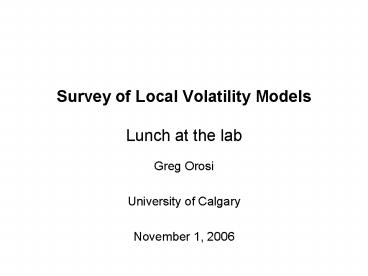Survey of Local Volatility Models Lunch at the lab - PowerPoint PPT Presentation
1 / 22
Title:
Survey of Local Volatility Models Lunch at the lab
Description:
Penalized Spline. Genetic algorithm. Conclusion. Assumptions of ... Smoothness Penalization ... Smoothness Penalization. Implemented by Jackson and Suli -1999 ' ... – PowerPoint PPT presentation
Number of Views:46
Avg rating:3.0/5.0
Title: Survey of Local Volatility Models Lunch at the lab
1
Survey of Local Volatility ModelsLunch at the
lab
- Greg Orosi
- University of Calgary
- November 1, 2006
2
Outline
- Volatility Smile and Practitioners Approach
- Polynomial model for Local Volatility
- Spline Representation
- Penalized Spline
- Genetic algorithm
- Conclusion
3
Assumptions of the Black-Scholes model
- Black-Scholes assumes constant volatilities
across all strikes and expiry - But implied volatilities from market exhibit a
dependence on strike price and expiry - Possible reasons for the smile
- -Real prices have fatter tails than GBM
- -News events cause jumps
- -Supply and demand considerations (investor
preference)
4
Implied Volatility Surface
- Implied volatility surface for SP 500
5
Explaining the Smile
- Many attempts to explain the Smile by modifying
the Black-Scholes assumptions on dynamics of
underlying asset returns. - Jumps Merton, 1976
- Constant Elasticity of Variance (CEV) Cox and
Ross, 1976 - Stochastic Volatility Heston, 1993
- These provide partial explanations at best
6
Practitioners approach
- Practitioners model the implied volatility
surface as a linear function of moneyness and
expiry time - This consists of computing implied volatilities
and performing an OLS regression - The model is inconsistent but it works well for
vanilla options. Bruno Dupire "Implied
volatility is the wrong number to put into wrong
formulae to obtain the correct price.
7
Another IV surface example
8
Local Volatility Model
- Using IV surface to price path dependent options
will lead to arbitrage because of inconsistency - Derman, Kani and Kamal (Goldman Sachs
Quantitative Research Notes 1994) suggest local
volatility approach - Financial perspective model is preference free
- Get Generalized BS-PDE
9
Dupires Equation
- In 1994, Dupire ( Pricing with a smile. Risk
Magazine) showed that if the spot price follows
GBM, then local volatilities are given by - Where C is the constant volatility BS option
price - Therefore, Dupires equation provides link
between IVS and local volatility surface - However, this formula has little practical
importance
10
DWF model
- Therefore, local volatility has to be calculated
from option prices by minimizing - In 1998 Dumas, Fleming Whaley (Journal of
Finance Implied Volatility Functions Empirical
Tests) proposed a polynomial model of local
volatility
11
Empirical Performance of DWF model
- For hedging purposes DWF does not outperform
constant volatility Black-Scholes model - Overfitting the model leads to worse performance
(calibration is not well regularized) - So a trader is better off using the constant
volatility BS model to price an exotic option
instead of DWF
12
Spline representation
- Coleman, Verma and Li (1998) and Lagnado and
Osher (1997) suggest cubic spline representation
in - Reconstructing The Unknown Local Volatility
Function - The Journal of Computational Finance - A technique for calibrating derivative security
pricing models numerical solution of an inverse
problem - Journal of Computational Finance - Coleman et al show for long dated options the
model beats constant volatility BS in 2001
(Journal of Risk Dynamic Hedging in a Volatile
Market)
13
Spline representation
- A cubic spline is constructed of piecewise
third-order polynomias which pass through a set
of control points (knots). - The second derivative of each polynomial is
commonly set to zero at the endpoints and this
provides a boundary condition that completes the
system of equations.
14
Bounding
- Note that the spline based calibration is not
regularized, meaning more than one possible
solution. - This could lead to poor hedging performance
- Therefore, Coleman et al suggest strict bounding
15
Bounded Spline Example
16
Smoothness Penalization
- Lagnado and Osher (1997) suggest spline
representation and additionally penalizing the
smoothness - Define new objective with penalty
17
Smoothness Penalization
- Implemented by Jackson and Suli -1999
- Computation of Deterministic Volatility Surfaces
Journal of Computational Finance)
18
Tikhonov Regularization
- Crepey (2003) ( Calibration of the local
volatility in a trinomial tree using Tikhonov
regularization Inverse Problems) suggest
calculating local volatility by Tikhonov
regularization - Define new objective
19
Calibration by Relative Entropy
- A more general version of Tikhonov regularization
is calibration by relative entropy - See Cont and Tanakov (Calibration of
Jump-Diffusion Option Pricing Models A Robust
Non-Parametric Approach Journal of Computational
Finance - 2004) - This can be applied to other models besides local
volatility - Prior can be parameters estimated form historical
prices (e.g. mean reverting models)
20
Genetic Algorithm for Local volatility
- Because the objective in option calibration is
highly non-linear, gradient based optimization
methods perform poorly - Cont and Hamida (Recovering Volatility from
Option Prices by Evolutionary Optimization -
Journal of Computational Finance 2005) suggest
using Genetic Algorithm and spline representation - GA uses an initial population and improves this
population in each subsequent generation.
Therefore, the initial population can be
generated using a prior and the use of penalty
function is not necessary.
21
GA based local volatility for DAX
22
Conclusion
- Local volatility models can provide a consistent
theoretical option pricing framework. - However retrieving local volatility can pose
significant computational challenges.































